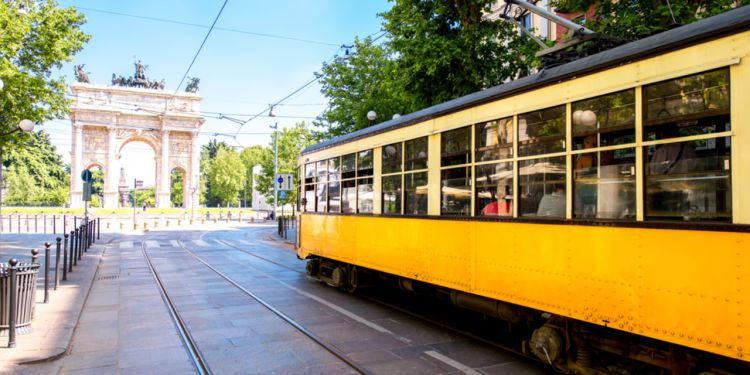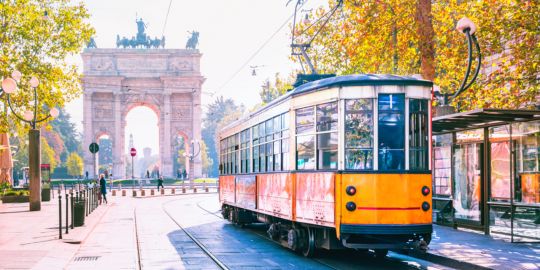Transports in Milan

Every day, thousands of people travel to and within Milan, whether by bus, train, metro, or taxi. The city has an efficient and well-developed public and private transport network. Here is some practical information to help you get around during your stay in Milan.
The wide variety of transportation in Milan
Traffic is undoubtedly the number one enemy of the citizens of Milan. From the early morning to the evening, traffic zones and other restrictions in the historic center and surrounding areas make it difficult to get around. In addition to traffic jams and restrictions (including Area C in the center), the limited number of car parks can make getting to and from the city a nightmare. However, the city also has several options for getting to the office and appointments on time. Milan's public transport system is well developed and connects many parts of the city: metro, bus and tram services are efficient and timely. More and more cycle lanes are being created in Milan, so you will see many cyclists braving the traffic to get around the city.
Taxis are undoubtedly the most expensive form of transport in Milan. They are available everywhere, and the cost varies according to the time of day: during the day on weekdays, the starting price is €3.70, and €1.20 per kilometer. During holidays and public holidays, the basic price is €6. At night, the fare starts at €7.20. You can book your taxi by phone by calling companies operating in Milan and via a mobile app, such as AppTaxi.
You can also use Uber, but unlike traditional taxis, the service is not metered or has a basic fare. The cost of a ride is determined by two criteria: the route and the type of car requested at the time of booking. The cost is usually the same as, or even higher than, that of regular taxis, as regulations in Italy are very strict in order not to compete with them.
Public transport in Milan
Milan's public transport system is managed by ATM, Azienda Trasporti Milanesi. It consists of five metro, bus and tram lines connecting many parts of the city. They are open from 06:00 to 00:30, and at night count on the night lines NM1 and NM2 (operating from 00:30 to 5:40), as well as trams 90 and 91, which run around the city until the next morning.
In addition, many metro lines also take you to the city's outskirts, turning into surface trains outside the urban area.
The metro lines in Milan are as follows:
- Line 1 (red);
- Line 2 (yellow);
- Line 3 (green);
- Line 4 (blue);
- Line 5 (purple).
According to the Moovit index:
- The average time spent in Milan on public transport is 43 minutes.
- The average waiting time at a stop in Milan on weekdays is about 9 minutes.
The price of the tickets varies from €2 to €4.40 depending on the zones of the city, which range from M1 to M9, and they can be used from 90 minutes up to 255 minutes to take the metro, bus, trams and trolleybuses. If you wish, you can apply for a daily or weekly pass or a monthly subscription. Again, prices vary depending on the urban area you are traveling in. For example, it will cost you more if you go to the "extra-urbana" area, which is outside the urban limit.
The Milanese public service ATM has also introduced the Radiobus di Quartiere program, which allows users to request the night bus service by phone or via the ATM app. The passenger can be picked up directly and taken to the destination of their choice. The service is available from 10 pm to 2 am and costs €2.
The ATM app is very useful for those who travel by public transport and want to plan their trips. It also provides information about problems on the lines, strikes, etc. Another application, Moovit, is useful for bus travel, and there is a collaboration with ATM. Finally, CityMapper is an efficient app that allows you to plan all your trips in the city.
Driving in Milan
If you have your own car, you'll need to be patient, both with traffic and parking in Milan. Also, beware of the driving style in Milan (and Italy, in general), which is frank and more chaotic than in the rest of Europe.
There are restricted areas in the center of Milan, such as Area C, which is a ZTL, a restricted traffic zone. Be aware that there are usually signs indicating the start of the ZTL and surveillance cameras that record number plates, which can lead to fines if the regulations are not respected. It is possible to buy passes to be able to circulate in the streets of the city center.
In terms of parking, it is advisable to rent a box in your neighborhood if you do not want to waste time looking for a parking space.
Good to know:
In Milan, the yellow strips are reserved for residents, and you need a vignette to park your car there without paying. Check with your local municipality for parking regulations.
Carpooling in Milan
In addition to traditional modes of transport, carpooling is another way to get around the city. Milan is the first Italian city to offer carpooling, which has many advantages, including parking, access to restricted areas, recharging and maintenance, all free of charge. The activation cost depends on the operator, but you can also find free versions. Rates range from around 20 cents per minute to €70 per day, depending on the operator, with some offering flash packages and other promotions. Popular operators include ShareNow, Enjoy, E-Vai, Zity and Refeel, the latter three offering a 100% electric fleet.
You can also benefit from bike-sharing services such as BikeMi (a service provided by the municipality of Milan), RideMovi, Lime and Swapfiets. To take advantage of this bike-sharing system, it is advisable to download the application of the operator of your choice.
If you prefer motorized two-wheelers in Milan, it is also possible to rent a scooter from Cityscoot, Cooltra, Govolt, or Mimoto.
Useful links:









